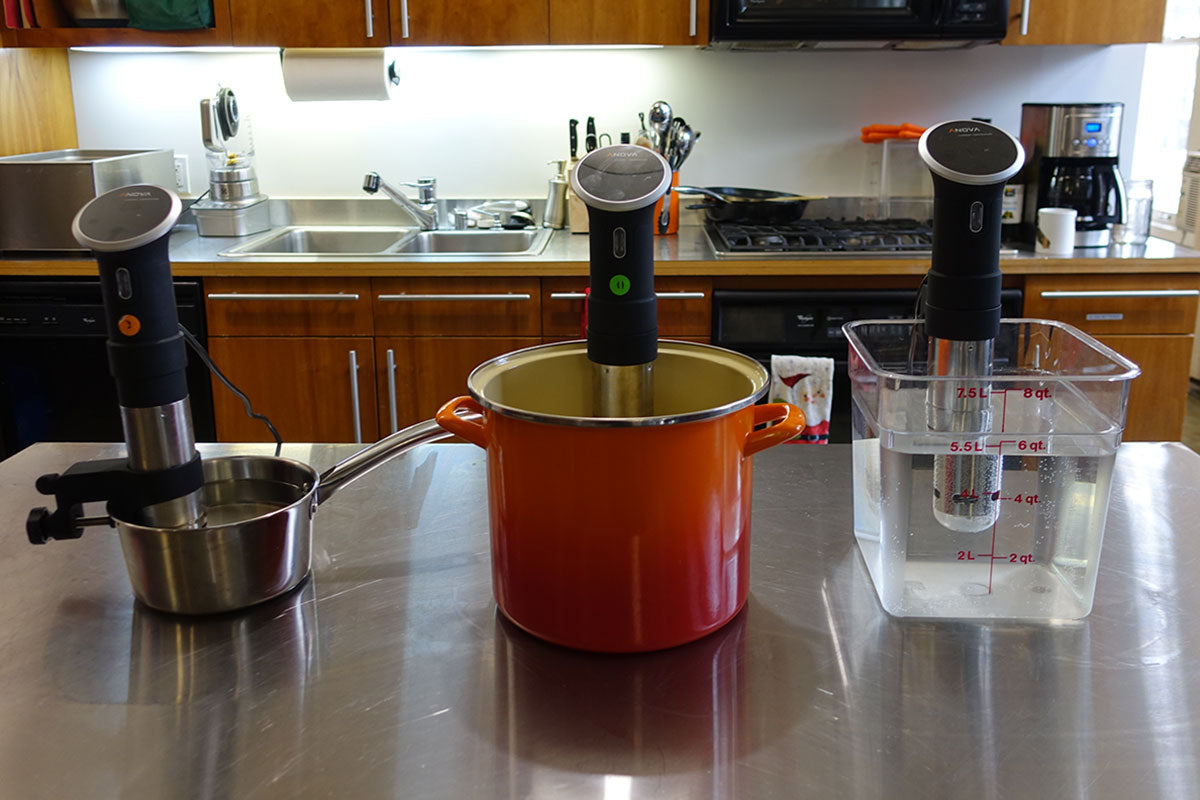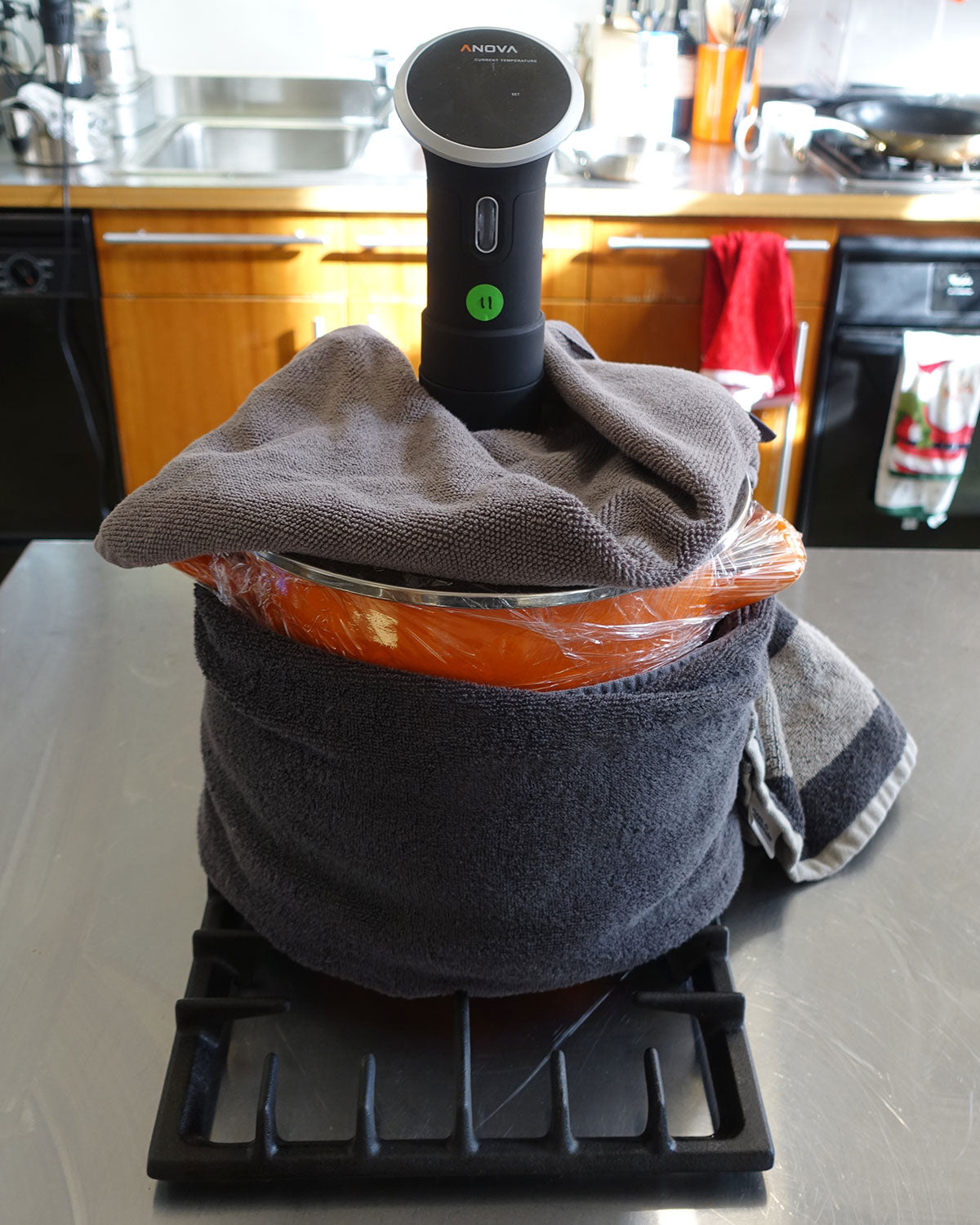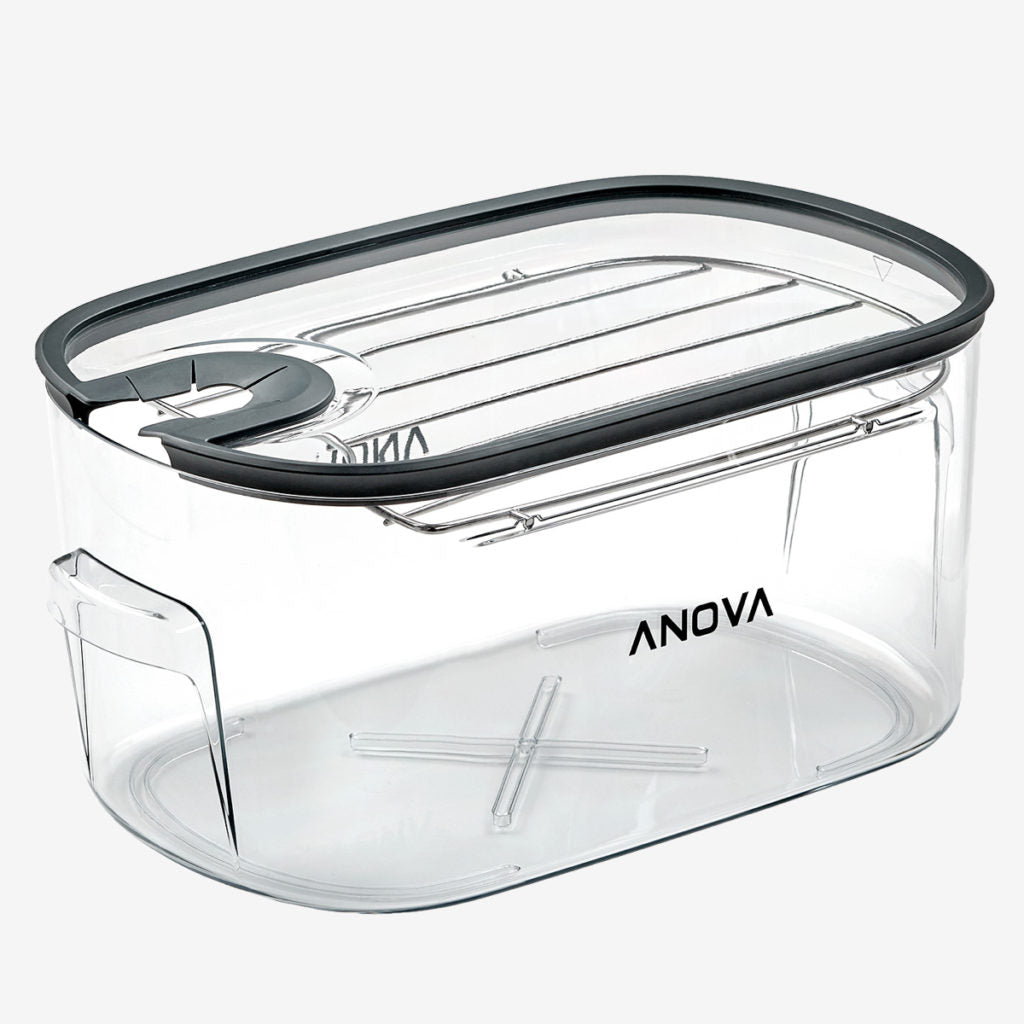One of the most basic and important pieces of information regularly sought in the world of precision cooking is what type of homemade sous vide container to use. There are so many options to choose from! Over the next few weeks, we are going to explore the ins and outs of this integral piece of equipment, culminating with a step-by-step guide of how to build your own Anova Frankencooler. This home-cooked cooler hack is the most efficient large sous vide pot you can make at home, just in time for the holidays! First, let’s go over the most important product specifications that govern the kinds of sous vide tub we can use.
What size container for sous vide?
-
Minimum water depth is 2.5 inches or 6.35 centimeters. You cannot use a sous vide container that is shallower than this.
-
The Anova Precision Cooker can accommodate up to 5 gallons of water, which is equivalent to 20 quarts or 18.927 liters. Whatever size sous vide vessel you choose, this is the maximum amount of water that will be supported without proper insulation.
-
The clamp for Anova is height-adjustable. You can move it up or down to best fit the height of your sous vide container.
- The clamp is also adjustable to accommodate different sous vide tub widths. That being said, the maximum width the clamp can accommodate is 1.25 inches, or 3.175 centimeters.
What kinds of sous vide containers can I cook in?
The most popular sous vide containers are the common stockpot and saucepan. In case you're wondering, the difference is that sauce pans tend to be smaller, ranging from 1 quart/0.946 liters to around 6 quarts/5.678 liters and generally have one long handle. Stock pots tend to be deeper, only starting out at 6 quarts/5.678 liters and reaching up to 150+ quarts/141.9 liters. You don’t usually see anything above 16 quarts/15.14 liters with stock pots. They typically have two small handles on either side to accommodate easier lifting of heavier sous vide pots. Both of these options work wonderfully, especially since most people already have them around the house. Of course, you must match the volume of the quantity you’re cooking to the size of the sous vide container. A single chicken breast will cook quite efficiently in a smaller container and need less water. A rack of lamb will require both a larger sous vide pot and more water. Oftentimes, we see people use polycarbonate tubs as a sous vide cooler hack. These are those fancy-looking clear tubs that you imagine a restaurant’s kitchen must be full of - and you wouldn’t be far off! They are available online as well as in restaurant supply stores. There is typically a full range of sizes from 1 - 22 quarts/1 - 20 liter. These are the most useful range of sizes for at-home sous vide cooking. Polycarbonate tubs do require an additional purchase, but you get to watch your food cook!
The last of the traditional household containers we tend to find our consumers using is the insulated cooler. I myself have resorted to Dutch ovens, deeper stainless hotel pans, large mixing bowls, Rubbermaid tubs, and plastic storage boxes from Costco, no lie. If it holds enough water and has a side you can clamp onto, you can likely use your Anova sous vide machine in it. It’s only a matter of time before I give my 5-gallon bucket from the hardware store or the kitchen sink a try!
Are there any sous vide containers I should avoid?
It’s a question I have legitimately been asked. The bathtub is not an appropriate sous vide vessel, for so many reasons that would require a whole different blog entry. Share your ideas about sous vide pots in the comments and I’ll bet we could put together a really funny community-generated post!What can I do to bring out the best in my sous vide container?
One word - INSULATION. Apart from the already-insulated cooler, one quality that all of the aforementioned sous vide containers share is poor insulation. Heat escapes both from the surface of exposed water and through conduction via the vessel sides. Luckily, there are simple tricks and methods you can employ with items you likely already have in the house to fight heat loss and increase the maximum capacity your Anova sous vide machine can handle.
Cover your sous vide pot.
Any cover at all will help stop the evaporation and heat loss from the surface. It can be as simple as Saran Wrap/cling film, or aluminum foil for higher temperatures. To further insulate, I like to put a clean folded bath towel on top of the wrap or foil. You can feel the heat being preserved without even looking at the device interface; the top of the towel will be cool while the bottom will be warm.

One very photo-friendly and evidently effective method is covering the sous vide surface with ping-pong balls, or the very special “sous vide balls” from the Sous Vide Guys. Not everybody has 50 - 250 ping pong balls laying around, so this may not be convenient. Also, you have to dry and keep them somewhere, but it’s an option. Many of the plastic and polycarbonate sous vide container options we mentioned lodge optional lids that you can easily cut a hole into along the edge to accommodate your sous vide Precision Cooker. The polycarbonate version does require some finesse because it cracks easily, as I've seen done many times in restaurant kitchens and food-nerdy home kitchens. Visit our community to discover the amazing wealth of techniques that Anova users have shared. The last option is to maintain surface heat integrity, which is currently more theoretical until I find a disposable foam cooler of the right size–is to make a custom-fit foam lid in the size of the opening of your container. I promise to add this process when we make a Frankencooler!
Wrap your sous vide vessel.
My go-to recommendation is to swaddle the sous vide tub in a bath towel or towels to keep that precious heat from dissipating through the sides, especially at higher temperatures. Even the pros ask this; just yesterday, a private chef friend of mine was having trouble getting her stainless pan to stay at 193ºF/89.4ºC and this is the exact advice I gave her. There are also some cases where we've heard of success using reflective barrier or denim insulation, both options found at home improvement or hardware stores.
Finally, and this is HUGELY important – make sure that your sous vide container is on a heat safe surface. I’ll bet you’re thinking that I'm going to recommend a bath towel again - and you wouldn’t be far off. This could definitely be an option for lower heat ranges. Better choices would be trivets and thick wooden or plastic cutting boards, but I would still put that famous bath towel underneath. NEVER put your sous vide container directly onto stone (marble, granite, Silestone, quartz, etc) or Corian counter. These surfaces tend to already have resin-filled microfissures that are invisible to the naked eye. Add heat, the resin expands, your counter cracks. And I mean CRACKS. I have heard Corian manufacturers and installers will actually not honor warranty claims where there is heat damage.
I don't recommend putting the sous vide container onto the stovetop, either. Primarily because of the chance that the flame may get turned on. That being said, the metal grate that holds the pan would be a great option to put onto your counter and place the vessel on top of that.
Looking for something a little less DIY?
Lucky for you, Anova comes through with not one, but TWO containers offering more sous vide cooking capacity and features (not to mention better looks) than your standard hacked-together home solution.1. The Anova Precision® Cooker Container

Less evaporation, plenty of room for activities, and more flow than your favorite rapper. This covered polycarbonate container was designed in-house to promote the most smooth, even, and circular water flow possible, with added features such as a raised base (to avoid damaging your counter top) and an integrated clip rack to keep your food from floating during a sous vide cook.
2. The Anova Precision® Cooker Insulated Container
 A fully insulated steel sous vide cooking vessel with quality you can feel. This countertop juggernaut was designed to look as good in action as it does just sitting there waiting for the next cook. Made to fit any Anova Precision® Cooker, this sous vide container makes use of double walled steel construction and a silicone coated steel flip lid to make sure you trap in as much heat as possible for the duration of your cook.
A fully insulated steel sous vide cooking vessel with quality you can feel. This countertop juggernaut was designed to look as good in action as it does just sitting there waiting for the next cook. Made to fit any Anova Precision® Cooker, this sous vide container makes use of double walled steel construction and a silicone coated steel flip lid to make sure you trap in as much heat as possible for the duration of your cook.
Shop Anova Precision Cooker Containers now!


9 comments
If I am preparing an 8 lb beef roast, should I divide into 2, to achieve proper cooking temp and time.
These are great tips. Long time home chef, first time sous vide’r. You answered all my questions on containers.
And to the comment above, Bruce, get yourself a better browser. This isn’t 1992
These are great tips. Long time home chef, first time sous vide’r. You answered all my questions on containers.
And to the comment above, Bruce, get yourself a better browser. This isn’t 1992
Your pop ups made me move away from your site. Ridiculously invasive while trying to benefit from your site. Good bye